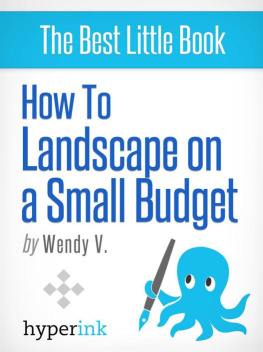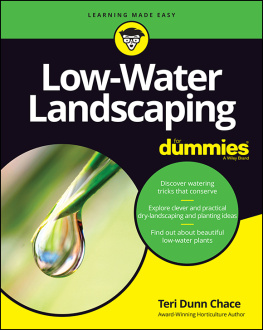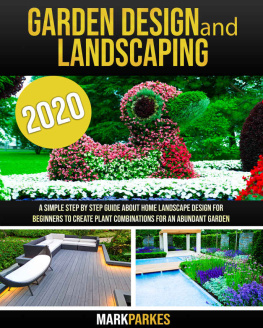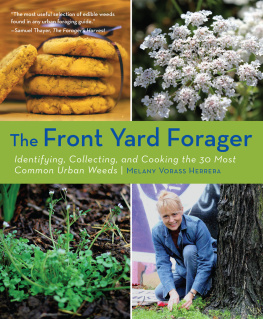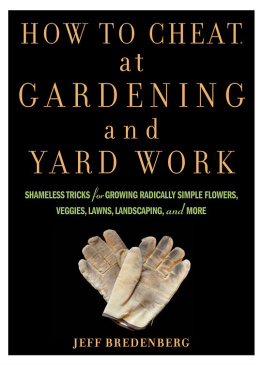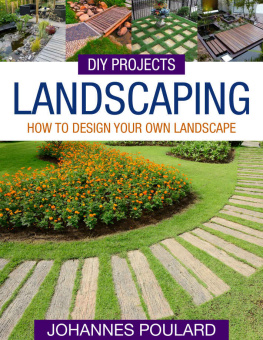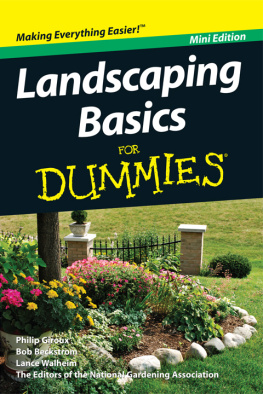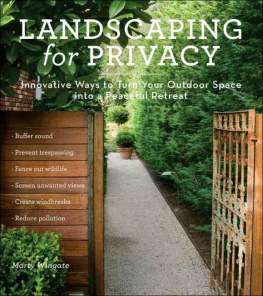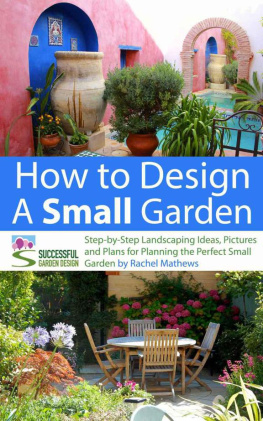How to Landscape on a Small Budget
Introduction
Anyone with a yard looks for the best way to make it beautiful without breaking the bank. Perhaps you are moving to a new house, with nothing but the blank slate of fresh dirt in the front yard without a tree to provide shade. Maybe youve just purchased a fixer-upper with overgrown shrubbery planted decades ago that has been allowed to overwhelm the entire front of the house. Or perhaps, youve been staring at your yard for years with the desire to improve it, but feeling that money is simply too tight to do any major overhaul of the space. Whatever your situation, you are in luck: great landscaping does not need to cost a fortune; it simply takes a bit of knowledge and common sense.
Landscaping can seem to be overwhelming to the beginning homeowner. After all, many people pay professional landscapers thousands of dollars for their services. But there are hundreds of gardening magazines, books, blogs, and video tutorials available, each offering advice on how to improve your front yard. Start your research by asking the following basic landscaping questions:
- Which plants will thrive in your area?
- What landscaping materials do you need, and where can you find them inexpensively?
- Is there a way to find plants for your yard at a lower cost? Can you create them yourself by growing them from seeds?
- Can you add to your living space by putting in a patio yourself? Where can you find the raw materials to do the project?
- Bags of conditioned soil are expensive at the nursery center. How can you create these soils yourself at a lower cost?
- What will add visual interest to my yard without breaking the bank on art objects?
Choose Your Plants
Designing your landscape on a budget starts with several simple steps.
1. Establish what gardening zone you live in.
When you are first starting out in designing your new landscape, you need go beyond looking trhough gardening magazines at the bookstore. Many of the photos that you will see, while beautiful, will not to work in your area. Before making any plans, use the United States Agriculture Departments website to look up your zone number to find out what plants thrive in your local climate. Simply input your postal zip code into the search box, and the website will tell you what your gardening zone is.
You will find that your local nurseries and gardening centers have done a great deal of the homework for you. Plants are marked by what gardening zone they belong in, and most of the plants available will be suited for your local zone.
If you are still not certain about what plants to use in your landscape design, chat it up with the people who work in your local garden center. They can tell you which plants are popular in your area. The nurseries will stock up on them in the hope of attracting customers. Make choices about the plants you want to incorporate and the type of mulch you will need for each bed you create.
2. Make a plan.
Now its time to dream up a landscaping plan . Do you want a lawn, or an alternative such as gravel? Will you be adding new paths, or perhaps a patio that will require hardscaping materials such as gravel, brick or tile?
Lawns
Putting in a lawn can prove to be one of the most expensive parts of a new landscape. While purchasing sod and laying it on a bare earth yard can create an instantly beautiful look, if the soil is not rich enough or the lawn is not evenly watered for the proper amount of time, it can grow brown and patchy in appearance.
A less expensive alternative is to cultivate your soil and then seed your lawn. Erect a simple barrier around your lawn patch to keep people and pets off the earth while the grass sprouts and fills in. This Old House explains how easy it is for a homeowner save money by prepping the soil in their yard properly and to seed their own lawn.
Hardscapes
Putting in patios, raised beds, retaining walls and other hardscape options are usually what eats up the gardening budget. Poorly placed berms or color beds can be expensive to remove if they do not please the eye. With a solid plan to follow, you will make fewer mistakes in your purchases and ultimately save a great deal of money.
Putting in a new patio or updating the paths to your front door does not need to be an expensive proposition. These hardscapes in your landscape can be made of broken pieces of concrete from an old patio, irregular flagstones combined with gravel between the pavers, simple squares of terracotta tiles or used bricks. All are popular choices to create organic-feeling walkways and patios. Shopping for materials during the off-season when many materials are on sale can help you save a lot of money.
A popular focal point in landscapes today is the water feature . You might assume that adding a fountain or pond to your yard will be expensive, but if you are willing to shop around for the needed materials and do the work yourself, it can be a cost effective piece to put in that will give you years of pleasure.
Plants
Buying plants in pots can prove to be a costly exercise in futility. You might be inclined to buy five-gallon potted plants, but purchasing one gallon potted plants instead can yield good results with savings. The plants will be smaller, but within a season they will grow and fill out a plant bed.
When you place the new plants, space them apart according to their mature size, not the size that they are at planting time. Use fertilizer as you plant to help give your new fledglings a stronger start. More care during planting will mean higher survival of plants as the season progresses.
Divide clumps of plants to create several starters to spread out in your beds as opposed to just putting the pot into one spot. Good candidates for splitting are grasses, perennial flowers such as geraniums, and plants that put out runners. Within a year or two, you can fill in a large bed with only the starting purchase of a few plants.
You can create new plants trees and roses, too; all you need is rooting hormones and some patience. For instance, if your friend has a rose bush that you admire, it is possible to clone a plant for yourself via propagation. Take a cutting at a natural divide in the cane and put rooting hormone on the cut end. Put the cutting into a pot of soil and let it take root. By next season you'll have a small rose bush to plant in your landscape. Trees are also good candidates for this method. In her article "No Budget? No Problem," horticulturist Karen Chapman explains how to save money by propagating plants, including simple steps on how to root lavender, a companion plant that often is used as ground cover under rose bushes.
Mulch
Organic mulch is a big part of beautifying your landscape and protecting young plants. According to "Organic Mulches And How To Apply Them," by Landscape for Life, mulch protects the soil from the elements, keeping the earth in place during rain and windy conditions. It helps to insulate the roots of your shrubs and flowers during extreme cold and heat. Next to having a lawn, few materials work better than a heavy mulch to cover your land. It is close to maintenance free and uses no water. Common materials used for organic mulch are bark, nutshells, pine needles, wood shavings, straw, compost, and leaves.
Bark is commonly available at nurseries and garden centers, but is one of the more expensive mulch covers. It should be applied several inches thick over the planting bed. It will protect your plants both in the winter and in the summer. As it breaks down, it provides nutrients to your soil.

